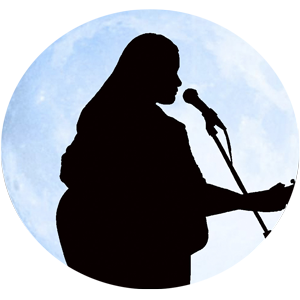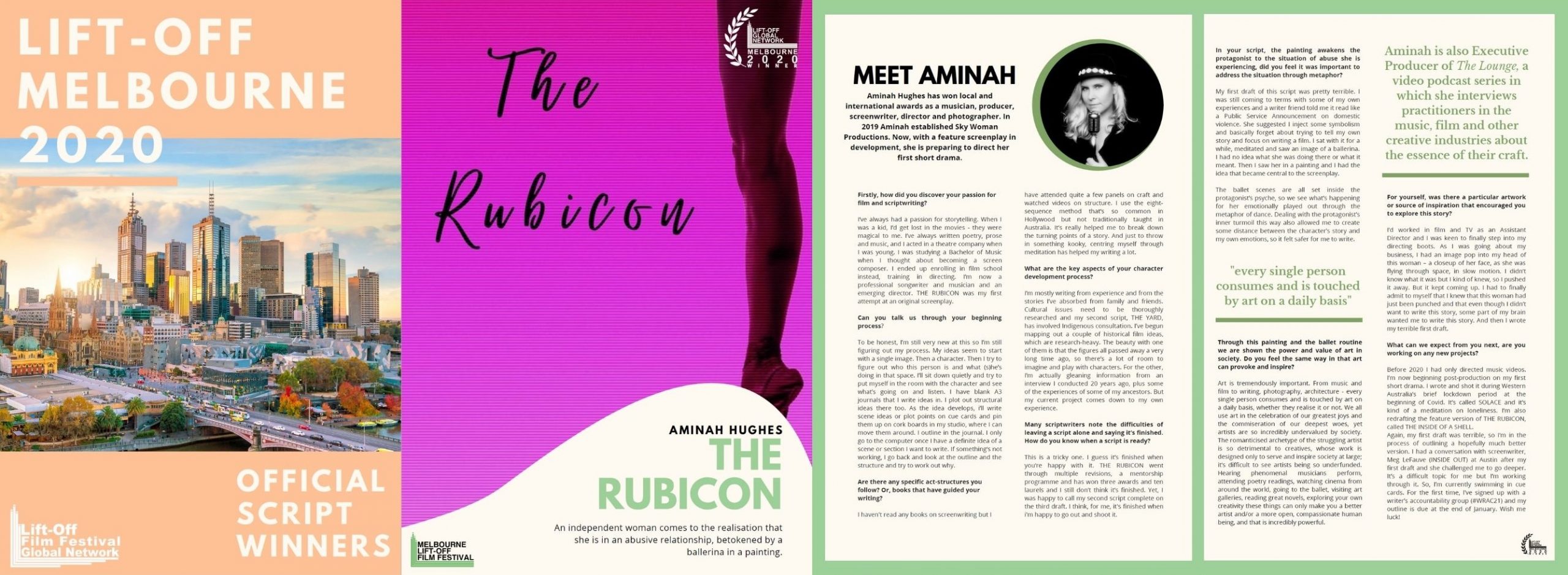In January, Aminah was interviewed by the London office of the Lift-Off Global Network, following her screenplay award win at the Melbourne Lift-Off Film Festival.
The interview was part of a larger article shared with members of the Network. Aminah was given permission to share an excerpt from the article with you. Transcript of her interview below!
***
Firstly, how did you discover your passion for film and scriptwriting?
I’ve always had a passion for storytelling. When I was a kid, I’d get lost in the movies – they were magical to me. I’ve always written poetry, prose and music, and I acted in a theatre company when I was young. I was studying a Bachelor of Music when I thought about becoming a screen composer. I ended up enrolling in film school instead, training in directing. I’m now a professional songwriter and musician and an emerging director. THE RUBICON was my first attempt at an original screenplay.
Can you talk us through your beginning process?
To be honest, I’m still very new at this so I’m still figuring out my process. My ideas seem to start with a single image. Then a character. Then I try to figure out who this person is and what (s)he’s doing in that space. I’ll sit down quietly and try to put myself in the room with the character and see what’s going on and listen. I have blank A3 journals that I write ideas in. I plot out structural ideas there too. As the idea develops, i’ll write scene ideas or plot points on cue cards and pin them up on cork boards in my studio, where I can move them around. I outline in the journal. I only go to the computer once I have a definite idea of a scene or section I want to write. If something’s not working, I go back and look at the outline and the structure and try to work out why.
Are there any specific act-structures you follow? Or, books that have guided your writing?
I haven’t read any books on screenwriting but I have attended quite a few panels on craft and watched videos on structure. I use the eight sequence method that’s so common in Hollywood but not traditionally taught in Australia. It’s really helped me to break down the turning points of a story. And just to throw in something kooky, centring myself through meditation has helped my writing a lot.
What are the key aspects of your character development process?
I’m mostly writing from experience and from the stories I’ve absorbed from family and friends. Cultural issues need to be thoroughly researched and my second script, THE YARD, has involved Indigenous consultation. I’ve begun mapping out a couple of historical film ideas, which are research-heavy. The beauty with one of them is that the figures all passed away a very long time ago, so there’s a lot of room to imagine and play with characters. For the other, I’m actually gleaning information from an interview I conducted 20 years ago, plus some of the experiences of some of my ancestors. But my current project comes down to my own experience.
Many scriptwriters note the difficulties of leaving a script alone and saying it’s finished. How do you know when a script is ready?
This is a tricky one. I guess it’s finished when you’re happy with it. THE RUBICON went through multiple revisions, a mentorship programme and has won three awards and ten laurels and I still don’t think it’s finished. Yet, I was happy to call my second script complete on the third draft. I think, for me, it’s finished when I’m happy to go out and shoot it.
In your script, the painting awakens the protagonist to the situation of abuse she is experiencing, did you feel it was important to address the situation through metaphor?
My first draft of this script was pretty terrible. I was still coming to terms with some of my own experiences and a writer friend told me it read like a Public Service Announcement on domestic violence. She suggested I inject some symbolism and basically forget about trying to tell my own story and focus on writing a film. I sat with it for a while, meditated and saw an image of a ballerina. I had no idea what she was doing there or what it meant. Then I saw her in a painting and I had the idea that became central to the screenplay.
The ballet scenes are all set inside the protagonist’s psyche, so we see what’s happening for her, emotionally, played out through the metaphor of dance. Dealing with the protagonist’s inner turmoil this way also allowed me to create some distance between the character’s story and my own emotions, so it felt safer for me to write.
Through this painting and the ballet routine we are shown the power and value of art in society. Do you feel the same way in that art can provoke and inspire?
Art is tremendously important. From music and film to writing, photography, architecture – every single person consumes and is touched by art on a daily basis, whether they realise it or not. We all use art in the celebration of our greatest joys and the commiseration of our deepest woes, yet artists are so incredibly undervalued by society. The romanticised archetype of the struggling artist is so detrimental to creatives, whose work is designed only to serve and inspire society at large; it’s difficult to see artists being so underfunded.
Hearing phenomenal musicians perform, attending poetry readings, watching cinema from around the world, going to the ballet, visiting art galleries, reading great novels, exploring your own creativity these things can only make you a better artist and/or a more open, compassionate human being, and that is incredibly powerful.
For yourself, was there a particular artwork or source of inspiration that encouraged you to explore this story?
I’d worked in film and TV as an Assistant Director and I was keen to finally step into my directing boots. As I was going about my business, I had an image pop into my head of this woman – a closeup of her face, as she was flying through space, in slow motion. I didn’t know what it was but I kind of knew, so I pushed it away. But it kept coming up. I had to finally admit to myself that I knew that this woman had just been punched and that even though I didn’t want to write this story, some part of my brain wanted me to write this story. And then I wrote my terrible first draft.
What can we expect from you next, are you working on any new projects?
Before 2020 I had only directed music videos. I’m now beginning post-production on my first short drama. I wrote and shot it during Western Australia’s brief lockdown period at the beginning of Covid. It’s called SOLACE and it’s kind of a meditation on loneliness. I’m also redrafting the feature version of THE RUBICON, called THE INSIDE OF A SHELL.
Again, my first draft was terrible, so I’m in the process of outlining a hopefully much better version. I had a conversation with screenwriter, Meg LeFauve (INSIDE OUT) at Austin after my first draft and she challenged me to go deeper. It’s a difficult topic for me but I’m working through it. So, I’m currently swimming in cue cards. For the first time, I’ve signed up with a writer’s accountability group (#WRAC21) and my outline is due at the end of January. Wish me luck!
















